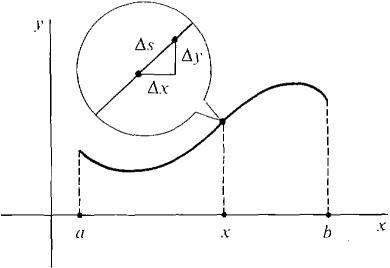| The ebook Elementary Calculus is based on material originally written by H.J. Keisler. For more information please read the copyright pages. |

|

Home  Applications of the Integral Applications of the Integral  Length of a Curve Length of a Curve  Segment of a Curve Segment of a Curve |
|||






|
|||
Segment of a Curve
A segment of a curve in the plane (Figure 6.3.1) is described by y = f(x), a ≤ x ≤ b. What is its length? As usual, we shall give a definition and then justify it. A curve y = f(x) is said to be smooth if its derivative f'(x) is continuous. Our definition will assign a length to a segment of a smooth curve.
Figure 6.3.1 DEFINITION Assume the function y = f(x) has a continuous derivative for x in [a, b], that is, the curve y = f(x), a ≤ x ≤ b is smooth. The length of the curve is defined as
Because
the equation is sometimes written in the form
with the understanding that x is the independent variable. The length s is always greater than or equal to 0 because a < b and
JUSTIFICATION Let s(u, w) be the intuitive length of the curve between t = u and t = w. The function s(u, w) has the Addition Property; the length of the curve from u to w equals the length from u to v plus the length from v to w. Figure 6.3.2 shows an infinitesimal piece of the curve from x to x + Δx. Its length is Δs = s(x, x + Δx).
Figure 6.3.2 The slope dy/dx is a continuous function of x, and therefore changes only by an infinitesimal amount between x and x + Δv. Thus the infinitesimal piece of the curve is almost a straight line, the hypotenuse of a right triangle with sides Δx and Δy. Hence
Then
Using the Infinite Sum Theorem,
|
|||
Home  Applications of the Integral Applications of the Integral  Length of a Curve Length of a Curve  Segment of a Curve Segment of a Curve |
|||
Last Update: 2010-11-25




 ,
, 


 (compared to Δx). Dividing by Δx,
(compared to Δx). Dividing by Δx,
 (compared to Δx).
(compared to Δx).
